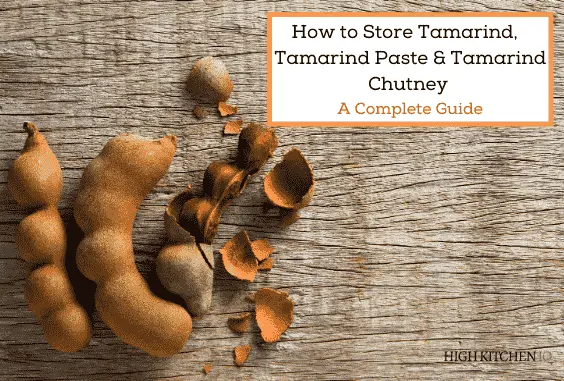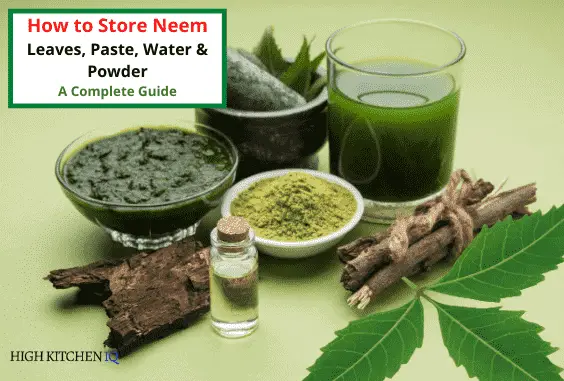How to Properly Store Tamarind, & Tamarind Paste & Chutney

Tamarind is one of those unique fruits that doesn’t have much information available online especially on how to properly preserve and store it. And I am a huge fan of tamarind so I wanted to fix this lack of information.
As usual, I did a lot of research and a few experiments, so, in this article, I will share with you the best methods that you can use to store your tamarind, tamarind paste, and tamarind chutney.
What is Tamarind and How does it Taste?
Tamarind is a member of the legume family. The tamarind plant is a tree, and its fruit is a legume, but often it is described as a pod.
When Tamarind is matured it has a dry brittle brown shell, that you have to crack open to get to the pulp. The part we eat is the pulp surrounding the seeds, which has a sweet and sour flavor that I would describe as being bright and citrusy. The pulp has fibers that you can remove before eating. The texture of the tamarind pulp is similar to that of dates.
The hard green pulp of a young fruit is considered by many to be too sour, but is still often used as a component of savory dishes, but as the fruit matures it becomes much sweeter with a mild tangy flavor.
Related Articles:
How to Store Butter- 5 Tips to Make it Last Longer
How to Store Tamarind with Shell For a Short Period
Tamarinds will be at it peak of flavor if eaten within a week once harvested. If you are planning to consume it within a short time, you can store Tamarind with the shell on at room temperature in a cool area.
At room temperature, they last a maximum of a week depending on how hot the temperature is. The hotter the weather, the faster the tamarind will ripen. To store at room temperature keep the tamarinds on the countertop uncovered if the shells have not been cracked open. The shell will keep the pulp fresh for a couple of days.
After harvesting, the flavor of the tamarind will begin to diminish when left at room temperature after 7 days.
How to Store Tamarind in the Refrigerator & Freezer for a long time
To prolong the freshness of tamarinds, it should be refrigerated. Tamarind stored in the refrigerator can last for 3 months but only if stored in an airtight container or resealable food safe bag in the refrigerator. The goal here is to keep it away from moisture which causes spoilage.
To keep your unshelled tamarinds good for a year you should store it in the freezer. To do so you need to freeze your tamarinds in a freezer-safe airtight container or a freezer-safe food bag. Remember to write the date it was placed in the freezer. The tamarind should be good to consume after a year but you will notice a difference in the flavor.
If you notice a change in the taste of your tamarind, throw out the batch and start afresh again.
How to Preserve Tamarinds with Salt
You can preserve your tamarind for a year without using a refrigerator or freezer, by using salt as a preservative as well as drying your tamarind.
Steps to Preserve Tamarind by Using Salt
- First, remove the shells of the tamarind.
- Then dry your deshelled tamarind in the sun for two days.
- Once completely dried use a small knife and remove the seeds of the tamarind, this is crucial.
- Next, place the tamarinds in a clean dry plate and add kitchen salt, liberally to the dried tamarind pulp.
- Using your hands to squeeze the dried tamarinds and salt together into balls, ensure your hands are completely clean and dry before squeezing them.
- Store the tamarinds balls with salt in either an earthen pot or a glass jar.
- You will notice that your tamarind will develop a darker color over time.
- Discard of tamarind if it shows signs of mold or gets soft.
- For more details, you can see how it’s done in the video below.
How to Make and Store Tamarind Paste so it lasts a long time
Tamarind Paste is easy to make and preserve at home but if you are purchasing the store-bought variety, it is best to follow the manufacturer’s direction on storage.
Steps to Making and Preserving Home-Made Tamarind Paste
This recipe makes 2 cups of Tamarind Paste and will last for at least 6 months in the refrigerator.
- First, place 1/2 lb of deseeded tamarind pulp into a bowl and cover it with 2 cups of hot water.
- Next, allow the tamarind pulp to sit in the hot water for 1/2 an hour.
- Once cooled use your hands squeeze the pulp and the water together, this is to remove the pulp of the tamarind from the fibers.
- Then strain the mixture using a sieve into a pot.
- To kill any harmful bacteria, bring the mixture to a boil.
- Remember to stir continuously while cooking the mixture.
- Once the mixture has been brought to a boil, allow it to cool.
- Then place the mixture into airtight containers and place into the refrigerator.
- This paste should last for at least 6 months in the refrigerator.
- Alternatively, you can place the paste into ice-cube trays and freeze them.
- Remove the frozen cubes and place them in freezer bags.
- Use as desired.
How to Store Tamarind Chutney for a long time
Tamarind Chutney adds a wonderful dimension to any dish. Make your favorite recipe and store for a long time by freezing the chutney in an airtight container or for a quick defrost you can store them in ice cube trays.
Once frozen remove the cubes and place them in resealable bags. Place the resealable bags in the freezer.
When you are ready to use the chutney, defrost and take as much as you want and reheat in the microwave or pot. Place the remainder of the unheated chutney back into the freezer. Frozen tamarind chutney can last for 6 months in the freezer.
Uses of Tamarind
Tamarind is used in cuisines all around the world because of the sweet and sour flavor it imparts. Growing up I ate many dishes made from tamarind, and I am aware of the delicious flavor that it imparts in curries, marinades, chutneys, and drinks. Tamarind is also a key ingredient found in the very popular Worcestershire sauce.
It can also be used as well in traditional medicine because of its many health benefits and as a metal polish since it contains tartaric acid, which helps remove tarnish from copper and bronze.
.





